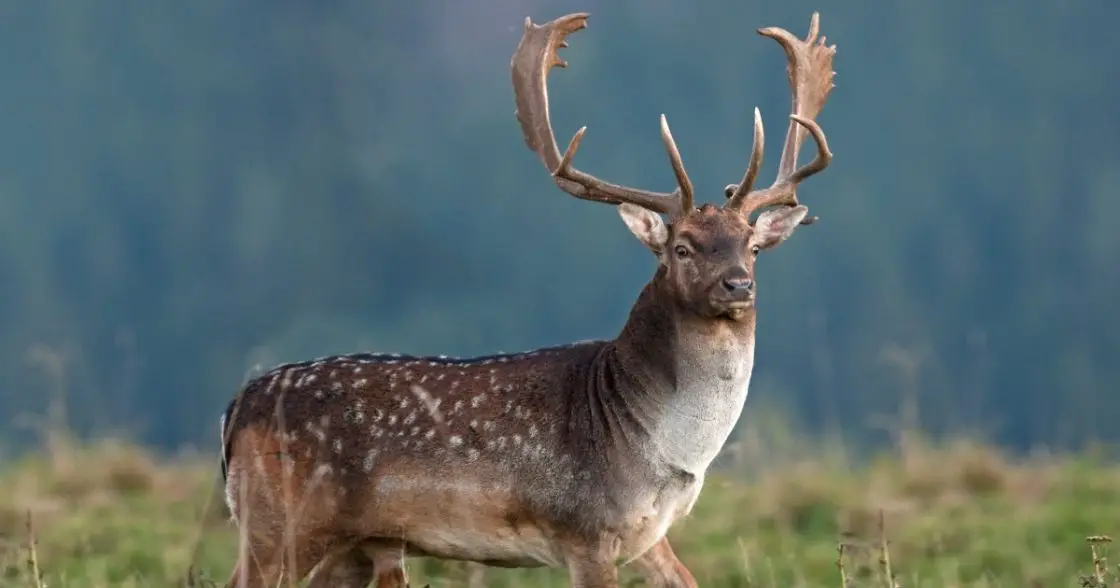The Fallow Deer (Dama dama) is a European native species of deer with an impressive rack of antlers (males) and striking appearance. Its name is derived from the pale brown coloration of its body, although there is significant variation in the coat color of this species in different parts of the world.
On this page we’ll share key information about the size, distribution, preferred habitat, reproduction, and distinctive behavior of the Fallow Deer.
What Size are Fallow Deer?
- Head & Body Length – 140 to 190 cm
- Shoulder height – 80 to 110 cm
- Tail length – 14 to 25 cm
- Weight – 25 to 130 kg
What Do Fallow Deer Look Like?
The Fallow Deer is a slender, medium sized deer. It is quite distinctive in appearance because of its characteristic markings.
It is not as stocky as many other species of deer. The legs are long and slender. The head is thin and narrow, and carried by a long neck.
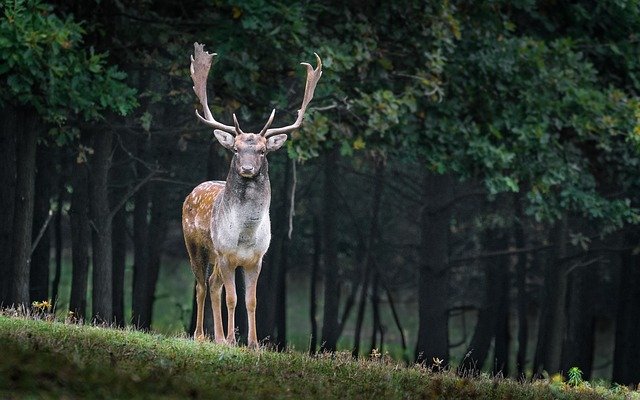
The Fallow Deer has a graceful appearance, which along with its placid temperament has made it a popular parkland deer.
Summer Coat & Markings
The summer coat is distinctive in coloration and patterning, most animals have flanks that are a pale chestnut brown color, these are dappled with white or creamy colored spots.
The belly and lower parts of the neck are white. The insides of the legs are also pale in color or white.
The summer coat is short and shiny.
Winter Coat & Markings
The winter coat is longer and much drabber in color, growing from late autumn onwards.
During the winter months the coat is much darker in color than the summer coat and the flank spots disappear. The winter coat is molted in spring around April or May.
The rump patch stands out well and is a large white disk of fur, that is bordered by a black rim. The tail is long and has a black tip, making it conspicuous against the white of the rump patch.
Although most animals are a chestnut brown color, there are a number of different color variations within the Fallow Deer species. All black or all white animals are not uncommon.
Some animals have what is called a ‘menil’ coat, which is a richer color of brown and which has many more white spots than what is normally observed among Dama dama.
Male Fallow Deer Appearance
Males, which are known as bucks, are larger and heavier in size than the females, or does. The bucks tend to have larger more muscular necks than the females. Bucks also carry antlers, which the does do not.
The antlers grow afresh each year. They are lost or cast in March or April, and a new set begins to grow straight away. The antlers reach there full size by about August, when velvet shedding occurs, and they are ready to use in the mating season about a month later.
The antlers in the Fallow Deer are impressive. Unlike most other deer, the antlers of the Fallow Deer are broad and flattened, being rather palmate in shape.
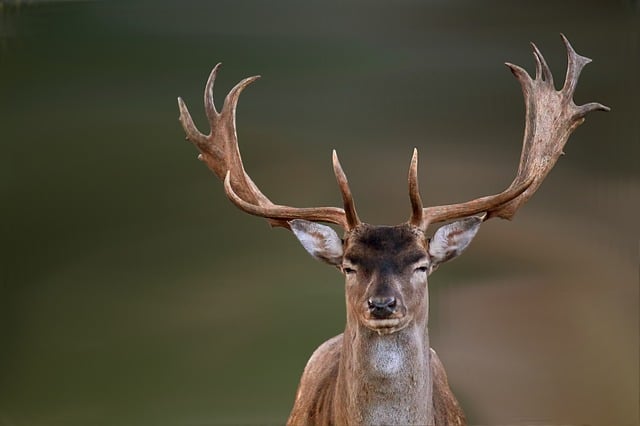
Combine this shape with their size (the antlers grow to over 70 cm in length). and they offer an unforgettable appearance when observed.
The tines at the front and middle of the antlers are the longest and, the other tines are extensions of the large flattened blade.
The size of the antlers depends on the age of the buck and other factors, with mature males in their prime years having the largest and strongest antlers.
Where Does the Dama dama Live?
During and shortly after the last ice age Fallow Deer were found in North Africa, Asia Minor and parts of the Middle East and Balkans.
However early hunting by man soon reduced the range of this species until they were found only in Asia Minor.
Ancient sailors such as the Phoenicians introduced Dama dama to new locations around the Mediterranean and increased its range. The Romans continued this process.
Later still, nobles stocked their hunting estates with Fallow Deer and further increased its range during the Middle Ages.
In Victorian times it became a popular parkland animal of rich gentry.
Modern Day Range
Today the Fallow Deer is found in many European countries. It remains a popular parkland deer, and is also often kept in deer enclosures.
There are a large number of wild living populations as well, but even though the Fallow Deer can be found in many areas, its distribution remains somewhat scattered and localized. They have also been introduced outside of Europe, notably into the USA.
Natural Habitat
Dama dama was originally a deer of open woodland and forest, being found mostly among woodland glades and opening clearings.
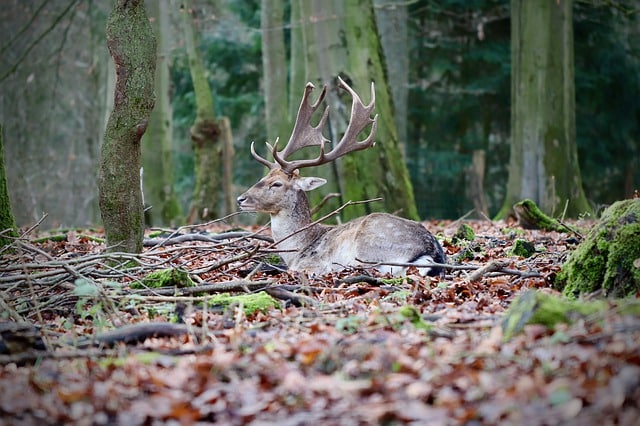
It has adapted well to living in parkland conditions, where there is light tree cover.
How Long do Fallow Deer Live?
Semi-wild or captive deer have a maximum lifespan of about 11 to 15 years.
In the wild, Fallow Deer do not live as long and are lucky to reach the age of 7 or 8 years.
What Do Fallow Deer Eat?
Fallow Deer are mostly grazers, feeding on grasses and a variety of herbaceous plants. They also often feed on trees and shrubs.
In areas where they are kept they will eat the lower parts of trees as high as they can reach, giving them a distinct shape.
Reproduction & Mating Habits of the Fallow Deer
The breeding season (or rut as it is known in deer) takes place during the late autumn and early winter, usually between October and December.
The Rut
During the rut the males become extremely excited and form small territories that they mark and fiercely defend from other Fallow bucks. This mating behavior is known as ‘lekking’.
Bucks can be extremely vocal during the rutting season. The males attempt to collect together and breed with small groups of females.
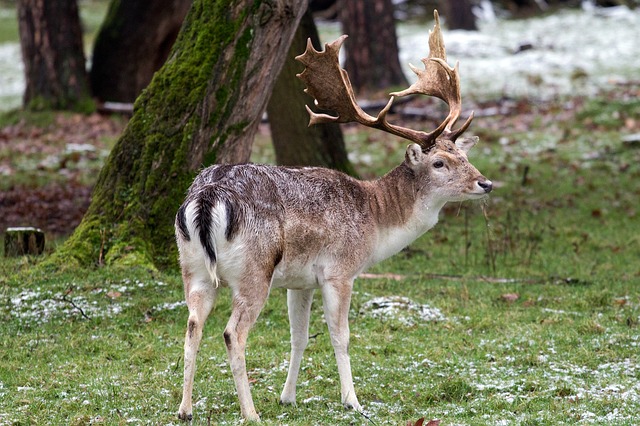
Bucks may fight over females using their antlers in ritualized contest to determine which male is strongest.
Gestation & Birth of Fawns
The fawns are born after a 230-day long gestation period.
Each female usually bears a single fawn, mostly around the month of June. The fawns are left by the mothers in long grass or in concealed clumps of vegetation, the fawns remain motionless, waiting for the mother to return, which she does several times a day to allow the fawn to be suckled.
The fawns remain hidden for the first 2 to 3 weeks of their life, after which they begin to accompany their mothers and the rest of the herd.
The newborn young have spotted coats that helps them to remain camouflaged in long vegetation. Fawns are weaned at 8 months of age, and become sexually mature when they are a year old.
Male Dama dama reach maturity slightly later than does.
Notable Fallow Deer Behavior
Fallow Deer are gregarious animals, living in small herds. The sexes live separately, with the females and the young living away from male herds.
Older males are typically solitary. Within the herds there is a strict dominance hierarchy, with certain individuals leading the group to new locations to feed and rest.
Fallow Deer feed at dawn and dusk and rest throughout much of the day.
The Dama dama is not territorial, herds move freely within large home ranges, which overlap with those of other herds.
When kept in parks or enclosures, Fallow Deer can become remarkably tame and are generally undisturbed by the presence of people. However, this belies the secretive and timid ways of wild living animals.
When alarmed they give out a short barking alarm call.

